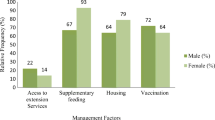Abstract
Rearing of scavenging chickens is among the most commonly practiced farm activities in Ethiopia. This system is dominated by indigenous chickens. Output from indigenous chickens is low due to poor management and absence of intense selection that is intended to improve economically important traits. This showed that village chickens are rather evolved for adaptation traits. However, the level of risk is low, and this has made rearing of scavenging chickens a choice of farm activity for smallholder farmers. The objective of this study was to characterize the scavenging chickens’ production system in Wolaita Zone. Single-visit survey involving individual interview of 119 farmers and 6 focus group discussions was used to collect the data. Our results showed that rearing of scavenging chickens was constrained especially by disease and predation problems. However, farmers proposed a set of solutions to minimize the effect of these problems. Rearing of scavenging chickens fulfils the multi-functional need of the society. This system has special features because it can sustain in its own without the need for modern commercial chicken farming facilities. However, farmers also reported the drawbacks of rearing of scavenging chickens and these mainly include uproot of garden crops and tiresomeness of the night watching. Selection of chickens was mainly depending on physically observed traits like body size and plumage colour. The initial foundation flock was mainly obtained from the local market. The ideal place for scavenging chickens production is the one that has intermediate weather condition and has some trees that can be used as shade; however, it was substantiated that it has to be free from bush and shrubs, weeds and wet lands. Therefore, these pieces of knowledge embedded among smallholder farmers need to be well documented and synthesized to design an appropriate type of technology packages that can be communicated back to farmers to improve productivity of the scavenging chickens.


Similar content being viewed by others
References
CSA, 2005b. Agricultural Sample Survey Statistical Bulletin, Central Statistical Authority (CSA), Addis Ababa, Ethiopia.
CSA, 2005a. Statistical report on farm management practices, livestock and farm managements. Central Agricultural Census Commission, Central Statistical Authority (CSA), 2004/2005 report, Vol. II, Addis Ababa, Ethiopia.
Dana, N., van der Waaij, L. H., Dessie, T. and van Arendonk, J. A. M., 2010. Production objectives and trait preferences of village poultry producers of Ethiopia: implications for designing breeding schemes utilizing indigenous chicken genetic resources, Tropical Animal Health and Production, 42, 1519–1529.
Dessie, T., 2003. Phenotypic and genetic characterization of chicken ecotypes in Ethiopia (unpublished PhD thesis, Humboldt University, Germany).
FAO, 2000. World Watch List of Domestic Animal Diversity, B.D. Scherf (eds.) Food and Agriculture Organization of the United Nations (FAO), Rome, Italy.
Guèye, E.F., 1998. Village egg and fowl meat production in Africa, World’s Poultry Science Journal, 54, 73–86.
Guèye, E.F., 2005. Gender aspects in family poultry management systems in developing countries, World’s Poultry Science Journal, 61, 39–46.
Hoffmann, I., 2005. Research and investment in poultry genetic resources–challenges and options for sustainable use: Reviews, World’s Poultry Science Journal, 61, 57–70.
ILCA, 1993. Handbook of African Livestock Statistics, International Livestock Centre for Africa (ILCA), Addis Ababa, Ethiopia.
Moges, F., Mellesse, A. and Dessie, T., 2010. Assessment of village chicken production system and evaluation of the productive and reproductive performance of local chicken ecotype in Bure district, North west Ethiopia, African Journal of Agricultural Research, 5(13), 1739–1748.
Mogesse, H. H., 2007. Phenotypic and genetic characterization of indigenous chicken populations in northwest Ethiopia (unpublished PhD thesis, Faculty of Natural and Agricultural Sciences, Department of Animal, Wildlife and Grassland Sciences, University of the Free State, Bloemfontein, South Africa).
Muchadeyi, F. C., Wollny, C. B. A., Eding, H., Weigend, S., Makuza, S. M. and Simianer, H., 2007. Variation in village chicken production systems among agro-ecological zones of Zimbabwe, Tropical Animal Health and Production, 39, 453–461.
Mwalusanya, N. A., Katule, A.M., Mutayoba, S.K., Mtambo, M.M.A., Olsen, J.E. and Minga, M.U., 2001. Productivity of local chickens under village management conditions, Tropical Animal Health and Production, 34, 405–416.
Olwande, P. O., Ogara, W. O., Okuthe, S. O., Muchemi, G., Okoth, E., Odindo, M. O. and Adhiambo, R. F., 2010. Assessing the productivity of indigenous chickens in an extensive management system in southern Nyanza, Kenya, Tropical Animal Health and Production, 42, 283–288.
Phiri, I. K., Phiri, A. M., Ziela, M., Chota, A., Masuku, M. and Monrad, J., 2007. Prevalence and distribution of gastrointestinal helminths and their effects on weight gain in free-range chickens in Central Zambia, Tropical Animal Health and Production, 39 (4), 309–315.
SAS 2002. SAS version 9.00, SAS Institute Inc. (Cary, North Carolina).
Sonaiya, E.B., 2009. Fifteen years of family poultry research and development at Obafemi Awolowo University, Nigeria. In: R.G. Alders, P.B. Spradbrow and M.P. Young (eds), Village chickens, poverty alleviation and the sustainable control of Newcastle disease. Proceedings of an international conference held in Dares Salaam, Tanzania, 5–7 October 2005, (ACIAR Proceedings No. 131), 15–26.
WZFEDD, 2005. Zonal basic socio–economic and demographic information, Wolaita Zone Finance and Economic Development Department (WZFEDD).
Yakubu, A., 2010. Indigenous chicken flocks of Nasarawa state, Nigeria: Their characteristics, husbandry and productivity, Tropical and Subtropical Agroecosystems, 12, 69–76.
Acknowledgements
We duly acknowledge farmers that participated in individual interview and focus group discussion for sharing their knowledge. The study cost of this project was covered by Wolaita Sodo Agricultural Technical Vocational Education and Training College.
Author information
Authors and Affiliations
Corresponding author
Rights and permissions
About this article
Cite this article
Desta, T.T., Wakeyo, O. Uses and flock management practices of scavenging chickens in Wolaita Zone of southern Ethiopia. Trop Anim Health Prod 44, 537–544 (2012). https://doi.org/10.1007/s11250-011-9933-y
Accepted:
Published:
Issue Date:
DOI: https://doi.org/10.1007/s11250-011-9933-y



